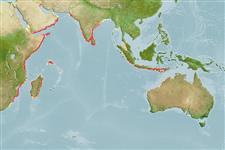Florideophyceae |
Ceramiales |
Ceramiaceae
Environment: milieu / climate zone / depth range / distribution range
Ecology
Sessile. Tropical
Indian Ocean: from the Arabian Sea south to South Africa, east to Sri Lanka.
Length at first maturity / Size / Weight / Age
Maturity: Lm ? range ? - ? cm Max length : 15.0 cm TL male/unsexed; (Ref. 82093)
Thalli are erect, to 15 cm high, pinnately branched up to 5 orders and lack a percurrent main axis. The holdfast is densely rhizoidal. Axes are corticated from close to the apices with corticating filaments arising from the periaxial cells, approximately 12-14 cells proximal to the apex. Proximal axial cells are 450-500 μm wide and 240-270 μm long. Each axial cell bears a single lateral in a distichous-alternate pattern. Determinate branchlets are ecorticate, curved upwards and up to 12 cells long. The basal 3 cells of a determinate lateral bear each a short adaxial side branch, the fourth to the ninth cell bear an arched abaxial branchlet and the remaining cells remain unbranched, except for the ultimate and penultimate cells, which bear 1-2 (-4) spine-like cells. Indeterminate branchlets are formed irregularly and repeat the branching pattern of the main axes. Tetrahedrally divided tetrasporangia (60 μm long, 40-50 μm wide) are borne laterally on cells of the ultimate branchlets. Gametophytes were not observed (Ref. 82093).
Euptilota fergusonii is distinguished from other Euptilota species inhaving spine-like cells at the tips of the determinate laterals. Thalli are erect, to 15 cm high, pinnately branched up to 5 orders and lack a percurrent main axis (Ref. 82093). Collected at two occasions only, at a depth of 15-25 m in northern Kwazulu-Natal, South Africa (Sodwana area) (Ref. 82093).
Life cycle and mating behavior
Maturity | Reproduction | Spawning | Eggs | Fecundity | Larvae
Guiry, M.D. and G.M. Guiry 2009 AlgaeBase. World-wide electronic publication, National University of Ireland, Galway. http://www.algaebase.org; searched on 14 April 2009. (Ref. 80701)
IUCN Red List Status
(Ref. 130435: Version 2025-1)
CITES status (Ref. 108899)
Not Evaluated
Not Evaluated
Threat to humans
Human uses
| FishSource |
Tools
More information
Trophic EcologyFood items (preys)
Diet composition
Food consumption
Predators
Population dynamicsGrowthMax. ages / sizesLength-weight rel.Length-length rel.Length-frequenciesMass conversionAbundance Life cycleReproduction
Maturity
Fecundity
Spawning
Eggs
Egg development
Larvae
PhysiologyOxygen consumption
Human RelatedStamps, coins, misc.
Internet sources
Estimates based on models
Fishing Vulnerability
Low vulnerability (10 of 100).
